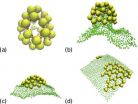(Press-News.org) Astronomy & Astrophysics published the first analysis of a catalog of 84 million individual stars in the Milky Way bulge as a part of the VVV ESO public survey. This gigantic data set allows building the largest, deepest, and most accurate color-magnitude diagram ever produced, containing more than ten times more stars than any previous study.
The bulge of the Milky Way is a large central concentration of ancient stars that is predominantly observed from the southern hemisphere. Understanding the formation and evolution of the bulge is fundamental for deciphering the properties of our Galaxy. In the bulge of the Milky Way, very faint individual stars can be observed, allowing astronomers to separate stellar populations based on age, kinematics, and chemical composition. However, the bulge is centered on the stellar disk of the Milky Way, where most of the stars, gas, and dust of our Galaxy is concentrated. This makes observations of the bulge very challenging because they are affected by crowding, extinction by interstellar dust, and the depth effect of stars being at a range of distances from us.
The VVV survey [1] is an ESO public survey conducted with the Visible and Infrared Survey Telescope for Astronomy (VISTA), located at the Paranal Observatory in Chile. VISTA is a 4.1-meter telescope performing surveys of the southern sky at near-infrared wavelengths. The VVV survey is dedicated to scanning the southern plane and bulge of our Milky Way in five near-infrared colors. Infrared wavelengths are less affected by extinction compared to visible ones, hence allowing the VVV survey to scan the heart of the Galaxy, where surveys in the visible range are limited by dust and gas. In addition, a four-meter class telescope such as VISTA yields much deeper observations than previous near-infrared surveys conducted with smaller telescopes.
In the paper published in Astronomy & Astrophysics, the team led by Chilean astronomers Roberto Saito and Dante Minniti and their colleagues [2] presents the analysis of a multi-color photometric catalog of the central concentration of stars in the bulge. This catalog consists of 84 million stars observed in three filters that covers 315 square degrees on the sky. Many individual catalogs generated by the VISTA calibration pipeline at the Cambridge Astronomical Survey Unit (CASU) were combined to produce this catalog. This enormous data set of individual stars has yielded the largest, deepest, and most accurate color-magnitude diagram ever produced for the bulge.
A color-magnitude diagram is a graph of the apparent brightness of an object vs. its color (its relative brightness in two different filters). These observed quantities can be related through models to stellar luminosity, temperature, mass, composition, and the amount of foreground dust. Each star occupies a single position in the diagram at any moment during its lifetime and, since we see the ensemble as a snapshot of the population (where each star has different mass and age), it is a census of the stellar component of the Galaxy. The diagram Saito and colleagues present in their paper registers the fingerprint of the structure and content of the Galaxy. For instance, one feature is the signature of the X-shape (or peanut shape) of the bulge. Another feature of the diagram reveals a significant population of red dwarf stars, which are valuable targets for searching low-mass extrasolar planets.
The VVV observations cover more than 500 square degrees of the Galactic bulge and plane using five filters. There is a related, not yet completed study that spans five years and searches for variable objects (such as pulsating stars, interacting binary systems, starspots) using one of the infrared filters.
### [1] VVV stands for VISTA Variables in the Via Lactea.
[2] The team includes R. K. Saito, D. Minniti, B. Dias, J. Alonso-Garcia, B. Barbuy, M. Catelan, J. P. Emerson, O. A. Gonzalez, M. Hempel, P. W. Lucas, M. Rejkuba, and M. Zoccali.
A 84-million star color-magnitude diagram of the Milky Way bulge
2012-10-24
ELSE PRESS RELEASES FROM THIS DATE:
Herbal and dietary supplements can adversely affect prescribed drugs says extensive review
2012-10-24
A number of herbs and dietary supplements (HDS) can cause potentially harmful drug interactions, particularly among people receiving medication for problems with their central nervous or cardiovascular systems.
Those are the key findings of an extensive research review published in the November issue of IJCP, the International Journal of Clinical Practice.
Researchers examined 54 review articles and 31 original studies. They found that the greatest problems were caused by interactions between prescribed drugs and HDS that included ingredients such as St John's Wort, ...
Mouse model exposes a new type of T cell to target melanoma
2012-10-24
October 24, 2012, New York, NY – Cancers arise in the body all the time. Most are nipped in the bud by the immune response, not least by its T cells, which detect telltale molecular markers—or antigens—on cancer cells and destroy them before they grow into tumors. Cancer cells, for their part, evolve constantly to evade such assassination. Those that succeed become full-blown malignancies. Yet, given the right sort of help, the immune system can destroy even these entrenched tumors.
In the October 22nd issue of the Journal of Experimental Medicine, researchers led by ...
A new take on the Midas touch -- changing the color of gold
2012-10-24
Red gold, green gold – a ground-breaking initiative has found a way of changing the colour of the world's most iconic precious metal.
A University of Southampton team have discovered that by embossing tiny raised or indented patterns onto the metal's surface they can change the way it absorbs and reflects light – ensuring our eyes don't see it as 'golden' in colour at all.
The finding results from a major initiative funded by the Engineering and Physical Sciences Research Council (EPSRC) targeting the development of a new generation of nanotechnology-enabled materials. ...
The majority of roadkill amongst vertebrates in Catalonia are in protected areas
2012-10-24
Amphibians are the vertebrate group that is more likely to become roadkill in Catalonia, even more so than reptiles, mammals and birds. This is the case according to an international team of scientists who have concluded that highly protected areas are home to more cases of animal death on the roads.
Our network of roads is considered one of the main threats to fauna survival. Researchers at the universities of Barcelona (UB), Porto (Portugal) and Uppsala (Sweden) have studied the number of vertebrate deaths on 820 kilometres of road in North Eastern area of Spain and ...
New insights into membrane-assisted self-assembly
2012-10-24
"In our current paper we present new computational results that explore how membranes may influence crucial biological processes", explains Richard Matthews, Lise-Meitner-Fellow at the University of Vienna and first author of the study. The focus of the investigation is the self-assembly of microscopic particles, the formation of structures or patterns without human intervention. More specifically, the effect of the interactions between membranes and proteins, which can influence the formation of ordered structures in cells, is considered.
Self-assembly has become a hot ...
Study: Flame retardant 'Firemaster 550' is an endocrine disruptor
2012-10-24
The flame-retardant mixture known as "Firemaster 550" is an endocrine disruptor that causes extreme weight gain, early onset of puberty and cardiovascular health effects in lab animals, according to a new study spearheaded by researchers from North Carolina State University and Duke University.
Firemaster 550 is made up of four principal component chemicals and is used in polyurethane foam in a wide variety of products, ranging from mattresses to infant nursing pillows. The flame-retardant mixture was developed by Chemtura Corp., and was first identified by the research ...
Voice prostheses can help patients regain their lost voice
2012-10-24
Help is on the way for people who suffer from vocal cord dysfunction. Researchers are developing methods that will contribute to manufacturing voice prostheses with improved affective features. For example, for little girls who have lost their voices, the improved artificial voice devices can produce age-appropriate voices, instead of the usual voice of an adult male. These advances in artificial voice production have been made possible by results achieved in a research project led by Professor Samuli Siltanen, results that are good news indeed for the approximately 30,000 ...
Unearthing a hidden dietary behavior
2012-10-24
Though it was identified as a disorder as early as the 14th century, pica, or the eating of non-food items, has for years believed to be all but non-existent in a few corners of the globe – a 2006 study that reviewed research on pica found just four regions – the South of South America, Japan, Korea and Madagascar –where the behavior had never been observed.
A new Harvard study, however, is showing that pica – and particularly geophagy, or the eating of soil or clay, is far more prevalent in Madagascar, and may be more prevalent worldwide, than researchers previously ...
Hypnosis helps hot flashes
2012-10-24
CLEVELAND, Ohio (October 24, 2012)—Hypnosis can help cut hot flashes by as much as 74%, shows a study supported by the National Center for Complementary and Alternative Medicine. This is the first controlled, randomized study of the technique to manage hot flashes, which affect as much as 80% of women who go through menopause. The study was published online this month in Menopause, the journal of the North American Menopause Society.
Controlled, randomized studies may pit an active drug against an inactive placebo pill. But it's hard to find a placebo for mind-body techniques. ...
Brainwave training boosts network for cognitive control and affects mind-wandering
2012-10-24
A breakthrough study conducted in Canada has found that training of the well-known brainwave in humans, the alpha rhythm, enhances a brain network responsible for cognitive-control. The training technique, termed neurofeedback, is being considered as a promising new method for restoring brain function in mental disorders. Using several neuroimaging methods, a team of researchers at the Western University and the Lawson Health Research Institute have now uncovered that functional changes within a key brain network occur directly after a 30-minute session of noninvasive, ...

